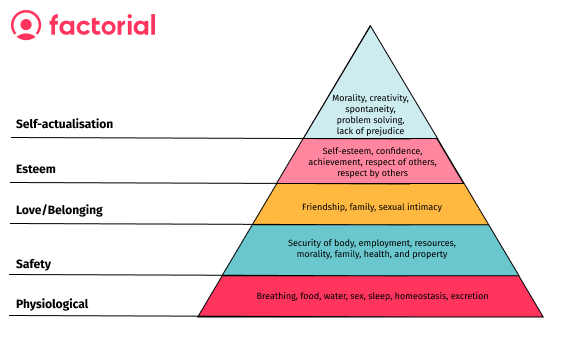Human resources (HR) and talent management are two terms that are intrinsically intertwined but most definitely not the same.
In this article, we’ll outline the difference and ensure you use the terms correctly. We start with a brief overview of the difference and then provide a bit of historical context to help you understand the development of the two terms before providing more detail on the skills required for both roles. We finish by considering how HR and talent management align with Maslow’s Hierarchy of Needs.
HR vs. Talent Management in a Nutshell
If you work in HR, you look after everything related to the people in an organisation to ensure that employees can fulfil the requirements of their roles to the highest possible standard in an environment that is safe, supportive and legal. This includes compensation, benefits, recruitment, training, performance and health and safety. HR works as the link between companies and their employees to ensure that everyone working for the organisation can meet the business’s objectives.
Talent management is a business activity that sits within HR and has a strategic focus. Talent managers work with the leadership team and the wider business to ensure the company attracts, retains and develops the right people to meet the business’s objectives now and in the future.
The History of HR and Talent Management
HR traces its roots back to industrialisation and the fact that larger workforces needed someone in the businesses to focus on recruiting and retaining skilled employees and handling the administration of paying workers. Over time this developed to include looking after the welfare of employees as well. After World War 2, the UK government specifically encouraged the creation of a ‘welfare officer’ within the nationalised industries to handle duties related to people, including negotiating with unions.
Then in the 1980s, human resources (also known as personnel) management arrived from the US and quickly became a firmly established and valued business department. While some railed against employee development and the idea that people were being treated in the same way as other resources, others welcomed the focus on employees as the most significant element of a business.

As the knowledge economy grew, more and more companies realised that people were their most significant asset, and a more strategic approach to recruitment and career development emerged. The 1997 McKinsey report “The War on Talent” is often seen as the point at which talent management was established as a critical function within the wider HR department. Now, any company that takes people development seriously has a clear talent management strategy.
For a different perspective related to this famous report, Malcolm Gladwell’s piece for The New Yorker in 2002 on ‘The Talent Myth‘ makes for an interesting read.
The Different Skills For HR vs Talent Management
A useful way to understand the difference between HR and talent management is to look at the required skills.
HR teams need to be:
- Good communicators (written & verbal)
- Problem solvers
- Negotiators
- Efficient and organised
- Able to prioritise, delegate and manage projects
- Emotionally intelligent
Talent managers also need to be:
- Strategic
- Innovative and creative
- Flexible and comfortable with change
- Good at networking and representing the brand externally
- Interested in technological developments

How Job Descriptions May Vary For the Two Roles
Another way to examine the difference between HR and talent management is to look at some of the duties that might be included in job descriptions.
Human Resources
If you work in HR, your role can include the following key components:
- The hiring process and recruiting new staff, including advertising roles and getting job descriptions ready.
- Making sure staff get paid correctly and on time.
- Managing pensions and benefits.
- Ensuring the welfare and health, and safety of employees.
- Monitoring staff performance and attendance.
- Organising staff training programs.
- Advising line managers on disciplinary and employee performance problems, as well as employment law and the organisations’ policies and procedures.
- Negotiating packages and handling redundancy of staff.
Many of these requirements are administrative or advisory, and essential to ensure a company has a fully functioning and highly effective workforce.

Talent Management
A job description for a talent manager or a talent pipeline leader is likely to have an obvious strategic focus:
- Creating and implementing a talent acquisition strategy to improve business performance.
- Developing strategies to identify skills gaps, attract diverse candidates and retain key talent.
- Acquiring knowledge and understanding of current and future trends and how these impact the business.
- Working closely with senior leaders to anticipate the organisation’s future and ensure the company has the right people for future business success.
- Ensuring performance management systems are fit for purpose in equipping businesses with the knowledge they need about their workforce.
- Overseeing the development of talent through individual and team training programmes.
- Developing employee retention strategies and monitoring staff turnover.
Maslow's Hierarchy Of Needs
Lastly, an alternative way of looking at the difference between HR and talent management is to think of the two areas in the context of Maslow’s Hierarchy of Needs. Maslow’s work focuses on what motivates us, which naturally links to how a company functions. Organisations with high levels of employee engagement are more likely to be successful.
His pyramid (shown below) illustrates that we need our basic physiological and safety needs met before we can build our self-esteem and fulfil our true potential through self-actualisation. Seen through the lens of human resource management, the HR department ensures that the needs identified in the bottom three layers of the pyramid are met. In comparison, the talent management team then focuses on the top two layers.
Some of the needs in Maslow’s pyramid are irrelevant to business organisations. Still, the central idea is that businesses need to look after the basic human needs of talented employees first before they can expect employees to flourish and deliver the business objectives.

Final Thought
The HR department lays the foundations for employee relations by ensuring employees are physically and emotionally safe, appropriately remunerated and treated well and within legal frameworks. In contrast, talent management builds on those foundations to create a successful business driven forward by the employees. By having a talent management framework, the business ensures the right people with the right skills are in the right roles, now and for the growth opportunities in the future.


